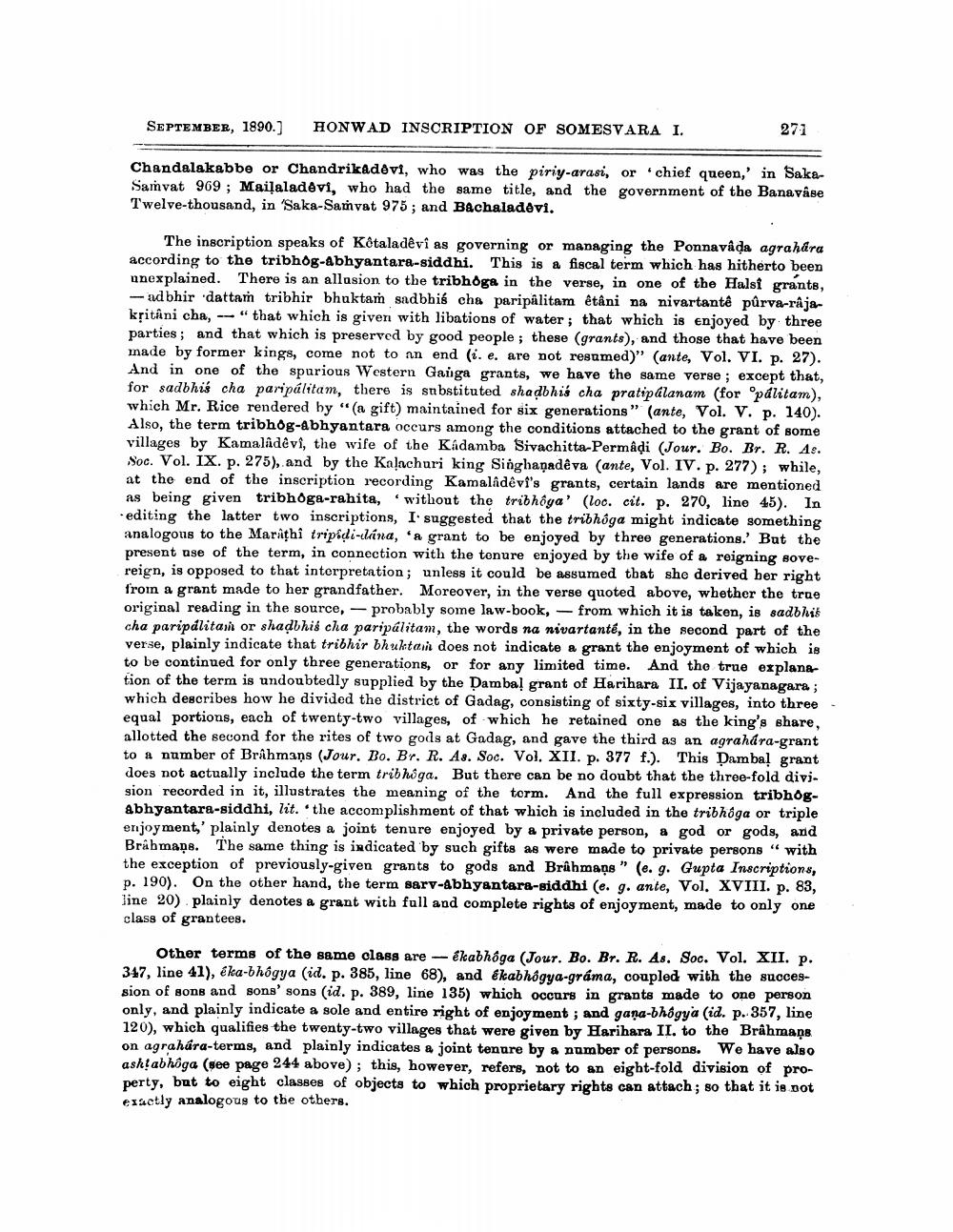________________
SEPTEMBER, 1990.7
HONWAD INSCRIPTION OF SOMESVARA I.
271
Chandalakabbe or Chandrikadovi, who was the piriy-arasi, orchief queen,' in SakaSamvat 969 ; Mailaladevi, who had the same title, and the government of the Banavåse Twelve-thousand, in 'Saka-Samvat 975; and Bachaladóvi.
The inscription speaks of Kôtaladêvî as governing or managing the Ponnavada agrahára according to the tribhog-Abhyantara-siddhi. This is a fiscal term which has hitherto been unexplained. There is an allusion to the tribhoga in the verse, in one of the Halsi grants, - adbhir dattar tribhir bhuktam sadbhis che paripálitam êtâni na nivartantê půrva-rajaksitâni cha, -- "that which is given with libations of water; that which is enjoyed by three parties; and that which is preserved by good people; these (grants), and those that have been made by former kings, come not to an end (i. e. are not resamed)" (ante, Vol. VI. p. 27). And in one of the spurious Western Gaiga grants, we have the same verse ; except that, for sadbhis cha paripálitam, there is substituted shadbhis cha pratipalanam (for opdlitam), which Mr. Rice rendered by "(a gift) maintained for six generations" (ante, Vol. V. p. 140). Also, the term tribhog-Abhyantara occurs among the conditions attached to the grant of some villages by Kamalâdêvi, the wife of the Kadamba Sivachitta-Permadi (Jour. Bo. Br. R. As. Soc. Vol. IX. p. 275), and by the Kalachuri king Singhanadêva (ante, Vol. IV. p. 277); while, at the end of the inscription recording Kamalâdêvi's grants, certain lands are mentioned as being given tribhoga-rahita, without the tribhôga' (loc. cit. p. 270, line 45). In editing the latter two inscriptions, I suggested that the tribhóga might indicate something analogous to the Marathi tripidi-lána, 'a grant to be enjoyed by three generations. But the present use of the term, in connection with the tenure enjoyed by the wife of a reigning sovereign, is opposed to that interpretation; unless it could be assumed that she derived her right from a grant made to her grandfather. Moreover, in the verse quoted above, whether the true original reading in the source, probably some law-book, - from which it is taken, is sadbhis cha paripdlitain or shadbhis cha paripálitam, the words na nivartanté, in the second part of the verse, plainly indicate that tribhir bhuktain does not indicate a grant the enjoyment of which is to be continued for only three generations, or for any limited time. And the true explang tion of the term is undoubtedly supplied by the Dambal grant of Harihara II. of Vijayanagara; which describes how he divided the district of Gadag, consisting of sixty-six villages, into threeequal portions, each of twenty-two villages, of which he retained one as the king's share, allotted the second for the rites of two gods at Gadag, and gave the third as an agrahara-grant to a number of Brahmans (Jour. Bo. Br. R. As. Soc. Vol. XII. p. 377 f.). This Damba! grant does not actually include the term tribhoga. But there can be no doubt that the three-fold divj. sion recorded in it, illustrates the meaning of the torm. And the full expression tribhogAbhyantara-siddhi, lit. the accomplishment of that which is included in the tribhoga or triple enjoyment,' plainly denotes a joint tenure enjoyed by a private person, a god or gods, and Brabmans. The same thing is indicated by such gifts as were made to private persons " with the exception of previously-given grants to gods and Brahmans" (e. g. Gupta Inscriptions, p. 190). On the other hand, the term sarv-Abhyantara-siddhi (e. g. ante, Vol. XVIII. p. 83, line 20) plainly denotes a grant with full and complete rights of enjoyment, made to only one class of grantees.
Other terms of the same class are ekabhôga (Jour. Bo. Br. R. As. Soc. Vol. XII. p. 347, line 41), éka-bhogya (id. p. 385, line 68), and ékabhôgya-gráma, coupled with the succession of sons and sons' sons (id. p. 389, line 135) which occurs in grants made to one person only, and plainly indicate a sole and entire right of enjoyment; and gana-bhôgya (id. p. 357, line 120), which qualifies the twenty-two villages that were given by Harihara II. to the Brâhmans on agrahara-terms, and plainly indicates a joint tenure by a number of persons. We have also asht abhôga (see page 244 above); this, however, refers, not to an eight-fold division of property, but to eight classes of objects to which proprietary rights can attach; so that it is not exactly analogous to the others.




